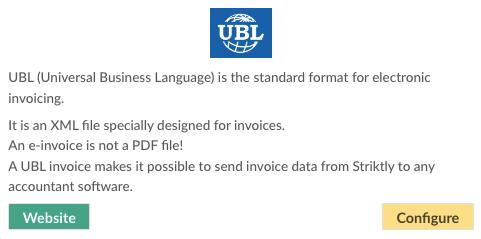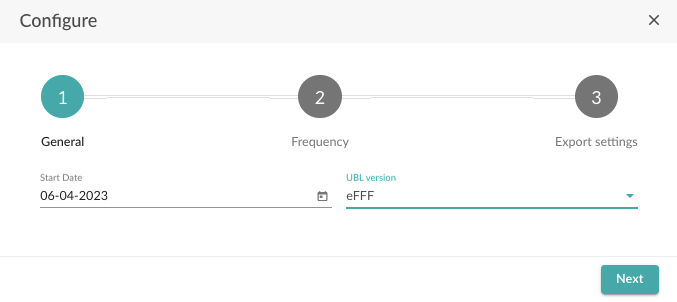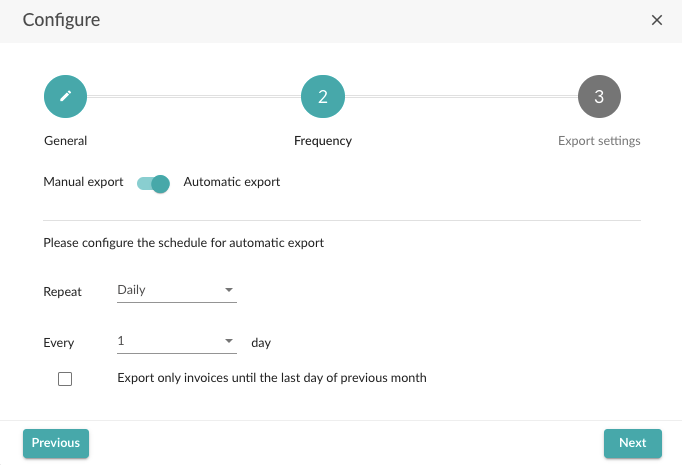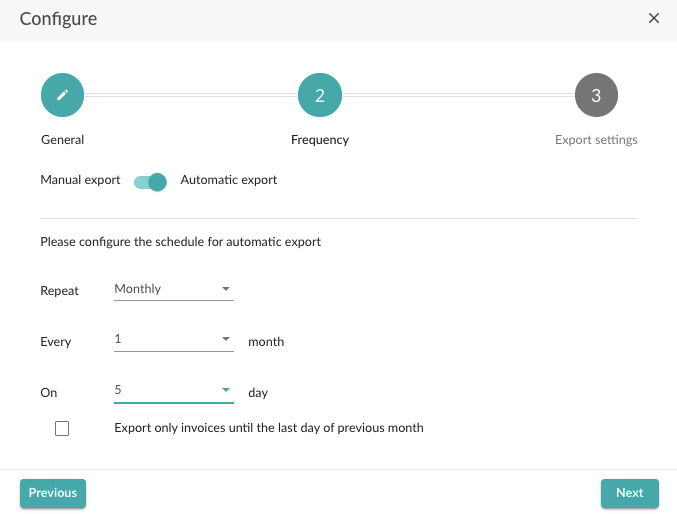How to link Go Getter with Twinfield
In the article below, we will focus on how to link Go Getter with Twinfield.
Currently, Twinfield only supports UBL import.
What do you need to successfully use this integration:
- The name of the accounting package used by your accountant
- The frequency at which the invoices should be sent
- The e-mail address the invoices should be sent to
Establish the connection:
- Log in to the admin panel and go to the "Integrations" tab.
- Navigate to UBL and select "Configure".
- On the next page, enter a start date (all invoices from this date onwards will be exported).
- In the second field, you select the UBL version supported by your accountant's software.
The UBL version is contingent upon the version supported by the accounting program that reads the UBLs. When in doubt, consult with either the accounting software manufacturer or your accountant.
- Select "Next".
On the next page, you can choose between manual or automatic export, we opt for automatic export.
- Adjust the frequency of exports. This can be daily, weekly or monthly.
- If you choose weekly or monthly, you can also specify the day on which the export should take place.
Most customers prefer scheduling a monthly export a few days into the new month, allowing for a comprehensive review by both you and your accountant.
It is important to note that filing VAT returns on a monthly basis is required, with a deadline on the 16th. To ensure adequate preparation time for your accountant, we recommend exporting data on the 5th day of the following month. Don't forget to select only the previous month's invoices before sending.
- After adjusting the settings, select "Next".
- Finally, fill in the e-mail address the invoices should be sent to.
- Select "Save".
If you have followed the steps correctly, your outbound invoices will now be automatically delivered to your accountant.
- After completion of the preceding steps, you will receive the following e-mail in your mailbox.
- Click on "Download" to download the UBL files in zip format.
- Open the file in order to extract the documents.
Efficiently streamline the UBL storage process for Twinfield by correctly placing the files from the ZIP archive on your computer.
Import UBL files into Twinfield:
- If you want to receive electronic invoices in Twinfield, you have two options. You can either opt to receive e-invoices through Basecone or process them directly within Twinfield.
- Do you use Twinfield Accounting in combination with Basecone? Go to Basecone's home screen followed by the delivery box. Here you can import the desired xml file.
- If the xml file does not yet contain an "embedded pdf file", you must deliver the UBL file via e-mail. Include both the xml and corresponding PDF file as attachments in the email.
In case the UBL version of the invoice cannot be accepted by Basecone or if the UBL file is incomplete, an error message will appear stating, "Failed: The document you supplied is not supported." This error message will only be displayed if receipt confirmation is enabled. You can also locate this error message in Basecone's email section. The UBL invoice is considered one document, and both the xml and pfd version are included. If you encounter the error message mentioned above, the administration will not process the pdf.
- All relevant data is now extracted from the xml file (such as invoice number, invoice amount, VAT number, IBAN, etc.) and used for the record proposal.
- In Basecone, if there is no existing customer or supplier match, the record rules extract relevant information from the xml for the purpose of maintaining accurate records. It is important to note the following rules:
- If there are total amounts per VAT% in the xml file, Basecone will suggest a breakdown per VAT%;
-
- If there are no such total amounts per VAT-%, the information for the record lines in the entry proposal is based on the information Basecone can extract per line from the xml;
-
- Per line, Basecone then takes the general ledger account, project, cost centre, VAT code, amount and/or description from the xml (if available and displayed in the way Basecone supports) and displays these in the record proposal.
- If a match can be made with an already existing customer or supplier in Basecone, then record rules may have been stored for this relationship in Basecone.
- Basecone utilizes the customer or supplier record information saved in its system to generate record proposals, replacing any information from the xml.
To ensure proper recording, priority is given to saved record rules for each customer or supplier. In case you do not want to apply the saved record rules, you have to remove them. Access "Settings" in Basecone, go to "Administration" - "Actions (edit)" - "Customers" or "Suppliers". Next, select the icon on the right and delete the record rules one by one (general ledger account, cost centre ... ).
If you have eliminated record lines for a UBL invoice with a previous record proposal, decline the invoice on the validation screen and re-tag it. This will prompt the creation of a new record proposal in accordance with the updated situation.
- If no record rules are stored in Basecone for the recognized customer/supplier, the record rule information is extracted from the xml in the same way as described above in scenario 1.
If a supplier or customer is not identified, record rules won't apply, as previously noted. However, when manually choosing a creditor/debtor with saved record rules, you'll receive the following notification: "Default record rules are at your disposal. Would you like to utilize them?" Once confirmed, the record proposal will be generated based on the saved record rules.
Automatically import UBL files into Twinfield:
- Acces the home screen of your Twinfield account, navigate to "Purchase" and select "Drag and drop or browse invoices".
- Next, go to the location where you stored the UBL files and select the desired invoice/invoices.
- Twinfield will send you a notification confirming the ongoing processing of your files.
- Before processing the invoice, ensure to review the imported document thoroughly for accuracy and correctness.
Note that there are no available screenshots in English of the above software package.









